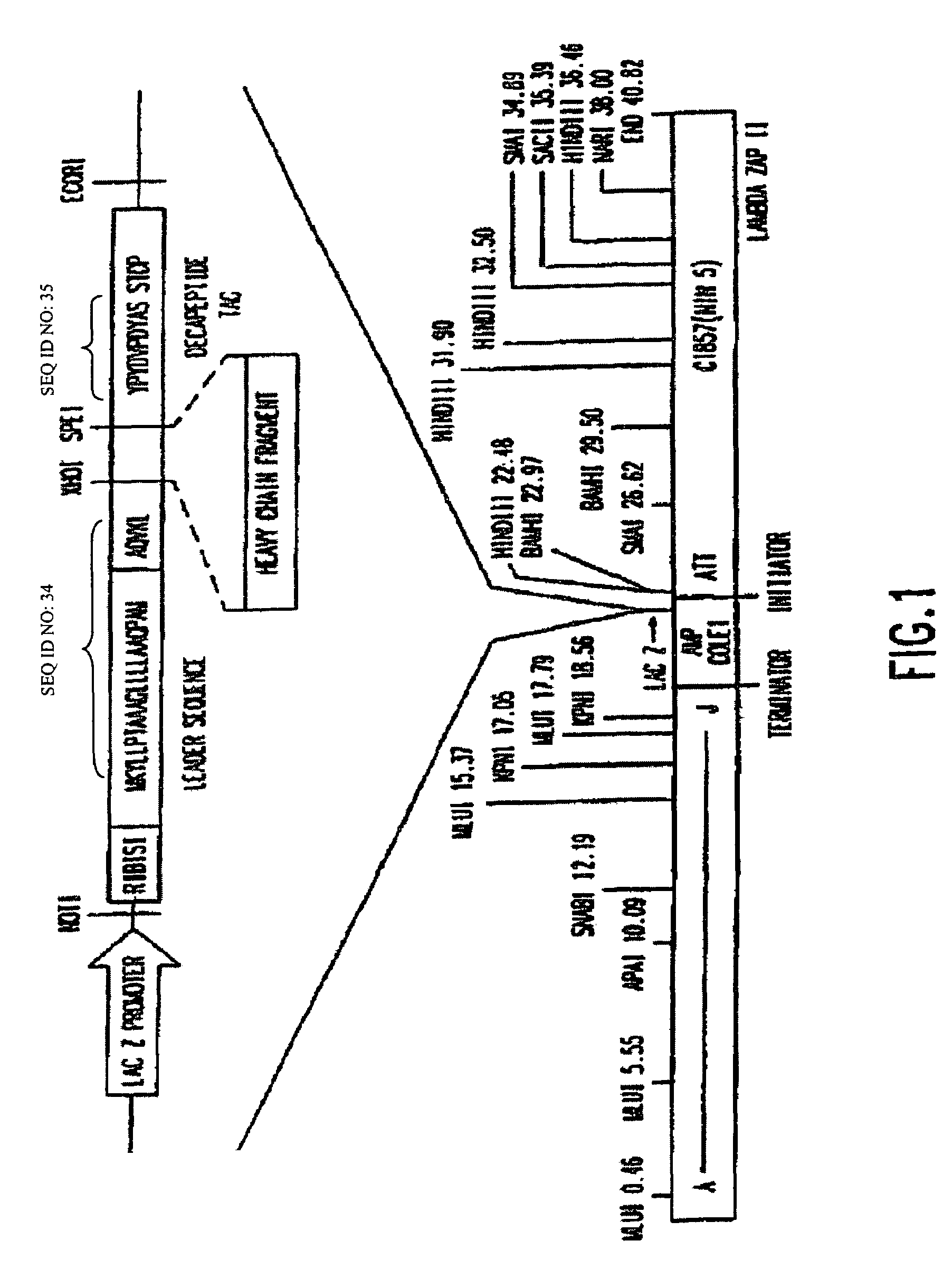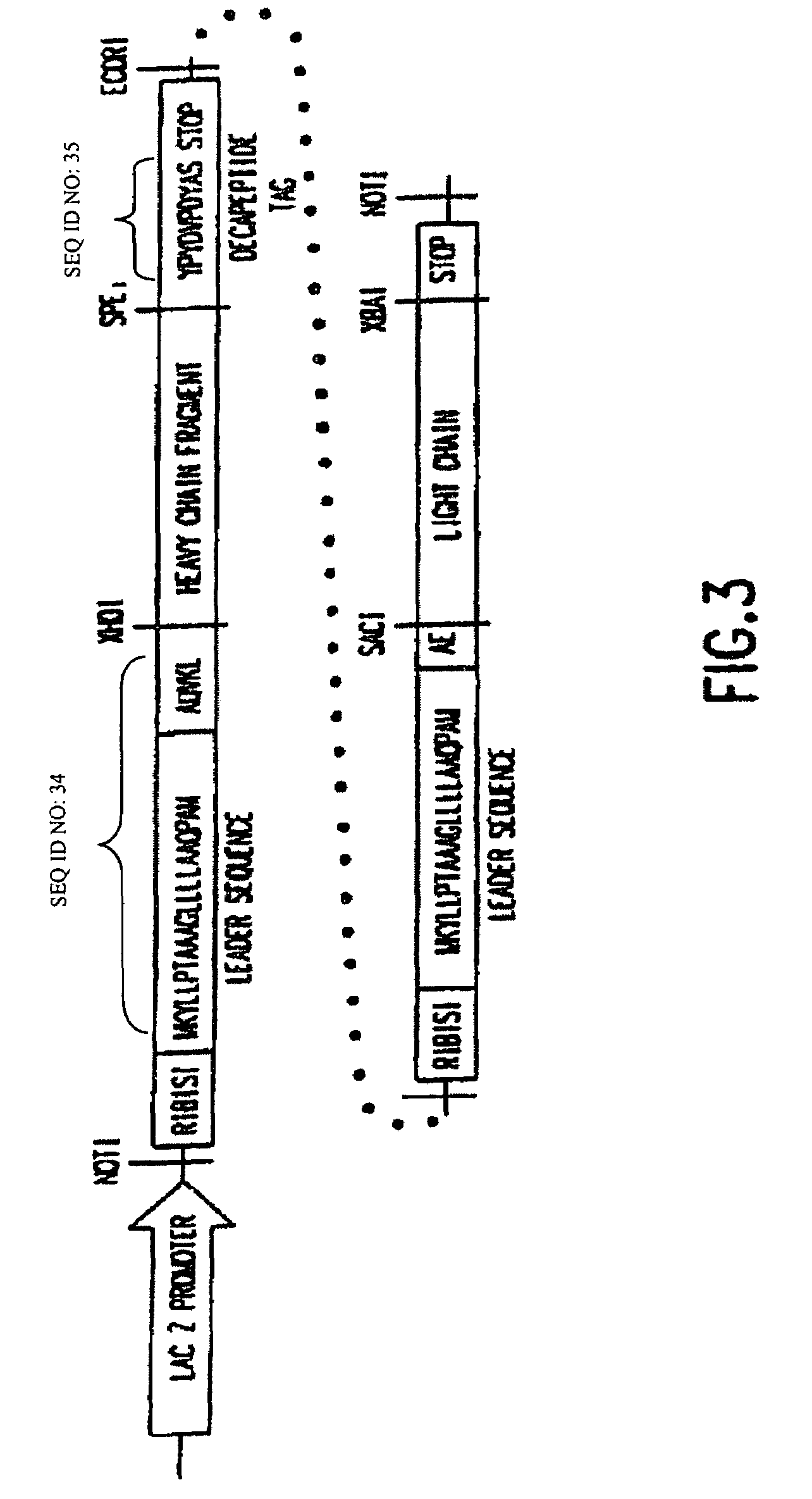Human neutralizing monoclonal antibodies to respiratory syncytial virus
a technology of monoclonal antibodies and respiratory syncytial virus, which is applied in the field of immunology, can solve the problems of not being practical and not having a rsv vaccine available, and achieve the effects of reducing problems, improving rsv disease efficacy, and improving therapy effectiveness
- Summary
- Abstract
- Description
- Claims
- Application Information
AI Technical Summary
Benefits of technology
Problems solved by technology
Method used
Image
Examples
example 1
Construction of a Dicistronic Expression Vector for Producing a Heterodimeric Receptor on Phage Particles
[0078]To obtain a vector system for generating a large number of Fab antibody fragments that can be screened directly, expression libraries in bacteriophage Lambda have previously been constructed as described in Huse, et al. (Science, 246:1275-1281, 1989). However, these systems did not contain design features that provide for the expressed Fab to be targeted to the surface of a filamentous phage particle as described by Barbas, et al. (Proc. Natl. Acad. Sci. USA, 33:7978-7982, 1991).
[0079]The main criterion used in choosing a vector system was the necessity of generating the largest number of Fab fragments which could be screened directly. Bacteriophage Lambda was selected as the starting point to develop an expression vector for three reasons. First, in vitro packaging of phage DNA was the most efficient method of reintroducing DNA into host cells. Second, it was possible to d...
example 2
Isolation of RSV-Specific Monoclonal Antibodies
[0109]Lymphocyte RNA preparation and library construction. The preparation of RNA from the bone marrow lymphocytes of an HIV-1 seropositive individual and construction of an IgG1x Fab library on the surface of phage using the pComb3 system were achieved as described previously (Burton, et al., Proc. Natl. Acad. Sci. USA 88:10134, 1991).
[0110]Panning of the library to select antigen binding phage, preparation of soluble Fabs and ELISA screening of Fab supernatants. ELISA analysis of the serum of the HIV-1 seropositive donor described in Burton, et al., supra, indicated a titer of approximately 1:3000 to RSV FG glycoprotein, therefore the same library was panned against recombinant FG glycoprotein coated on ELISA wells (1 μg / well of baculovirus-expressed FG fusion glycoprotein). Panning of the library was carried out as described (Barbas, et al., Proc. Natl. Acad. Sci. USA, 33:7978, 1991). Four rounds of panning produced an amplification ...
example 3
Neutralizing Activity of Fab Against Diverse RSV Isolates
[0116]The breadth of neutralizing activity of clone 19 was examined by testing it against an additional 9 subgroup A virus isolates as well as 9 subgroup B virus isolates. These viruses were recovered in different geographic areas over a period of 31 years. Virus neutralization was performed as described in Example 2. The purified Fab 19 preparation neutralized each of these preparations with high efficiency (Table 4). Additional studies showed that clone 11 also appears to have broad reactivity because it neutralized the subgroup B RSV prototype as efficiently as the subgroup A prototype and had broad neutralizing activity against the subgroup A and B viruses.
[0117]
TABLE 4NEUTRALIZING ACTIVITY OF Fab CLONE 19 AGAINSTDIVERSE RSV ISOLATES BELONGING TO ANTIGENICSUBGROUP A OR BSpecific Neutralizing ActivityRSV Isolates Testedof Fab Clone 19AntigenicNo.Temporal(Conc. of Fab (μg / ml) NeededSubgroupIsolatesDistributionfor 60% Plaque ...
PUM
| Property | Measurement | Unit |
|---|---|---|
| Fraction | aaaaa | aaaaa |
| Diameter | aaaaa | aaaaa |
| Dimensionless property | aaaaa | aaaaa |
Abstract
Description
Claims
Application Information
 Login to View More
Login to View More - R&D
- Intellectual Property
- Life Sciences
- Materials
- Tech Scout
- Unparalleled Data Quality
- Higher Quality Content
- 60% Fewer Hallucinations
Browse by: Latest US Patents, China's latest patents, Technical Efficacy Thesaurus, Application Domain, Technology Topic, Popular Technical Reports.
© 2025 PatSnap. All rights reserved.Legal|Privacy policy|Modern Slavery Act Transparency Statement|Sitemap|About US| Contact US: help@patsnap.com



